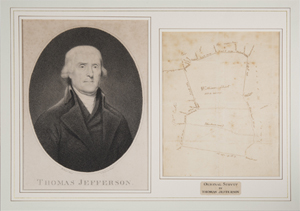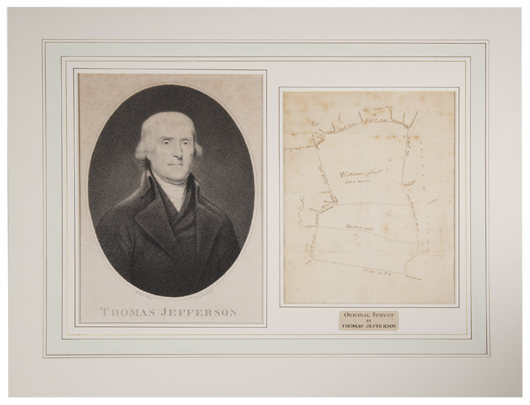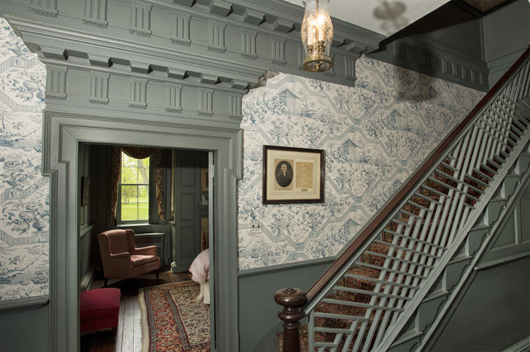Survey or plat of ‘Indian Camp’ in Albermarle County, Virginia, in the hand of Thomas Jefferson. Survey shows a 1,334-acre parcel adjoining the land owned by William Carter and James Monroe, which Jefferson purchased in 1796 on behalf of his protégé William Short (1759-1849). Today the land is known as ‘Morven’ and is owned and operated by the University of Virginia Foundation. Photo: Quinn & Farmer.
The document was discovered during the removal of personal property from Brandon, a working agricultural plantation south of Richmond, Va., that has been in continuous operation since 1619. Two Quinn & Farmer colleagues, Emilia Lanwehr and Skip Usry, were in charge of the removal, and as they were inspecting the home’s contents, one particular piece stood out: a framed survey of a 1,334-acre farm near Monticello that appeared to be hand-drawn by Thomas Jefferson himself.
Usry explained, “I spotted the map on the wall of a back staircase, nudged Emilia, and asked ‘Do you think it could be real?’”
Brandon Plantation was outfitted with high-end antique furnishings from the estate of the last owner of the historic farm, the late US Congressman Robert W. Daniel, Jr. (R-VA) who served five terms in the United States House of Representatives. Many of the pieces in the home were 18th- and 19th-century century English antiques, however the appraiser hired to evaluate the items had referred to the survey as a likely reproduction. Ken Farmer and Matthew Quinn, partners in Quinn & Farmer and appraisers for PBS’ Antiques Roadshow, were unconvinced. Investigating their hunch, they removed the item from its frame and discovered a 1798 watermark on the paper. Further research revealed an April 13, 1800 letter from Jefferson to William Short (for whom he had purchased the tract of land known as Indian Camp) in which he writes “I enclose you also a copy of the original survey.” Discussions with multiple Jefferson experts in Charlottesville determined that the document is both authentic and extremely rare, since Thomas Jefferson, unlike his father Peter, and, more famously, his contemporary George Washington, was not a surveyor by trade.
“Never before has an original hand-drawn Thomas Jefferson survey crossed the auction block,” said Ken Farmer. “We’re especially excited to offer this work here in Jefferson’s hometown of Charlottesville.”
BACKGROUND ON THE PROPERTY IN THE SURVEY:
William Short and Thomas Jefferson served together while Jefferson represented the United States as Minister to France in the 1780s. Upon Jefferson’s return to America, Short took a leading role with the embassy in Paris and went on to serve as Minister to both Holland and Spain in the 1790s, becoming America’s first career diplomat. During his tenure in Europe, he became an outspoken proponent for the abolition of slavery.
While the two friends shared a moral quandary with slavery, only Short proposed free African-American labor as the economically better alternative. He envisioned Indian Camp as an agricultural test site for the advantages of freed-African-American sharecropping over slavery. In a letter to Jefferson on February 27, 1798, Short wrote, “Whatever may be the result of the first essays, time & repetition will I think infallibly shew the advantage of free, above forced, labor.”
Although a believer, Short’s ideas would remain untested, and Indian Camp would never become a proving ground for abolitionist beliefs. The property remained in the hands of white tenant farmers and eventually was sold to another local farmer. Today, Indian Camp and its additions are known as “Morven,” which is owned and operated by the University of Virginia Foundation.
The Saturday, December 14, 2013 auction will be held at 10 a.m. EST at the Quinn & Farmer gallery located at 2109 India Road, Charlottesville, VA 22901. All forms of bidding will be available, including live online via LiveAuctioneers.
For additional information on any lot in the sale, call 434-293-2904 or e-mail information@quinnfarmer.com.
# # #
ADDITIONAL LOTS OF NOTE
Survey or plat of ‘Indian Camp’ in Albermarle County, Virginia, in the hand of Thomas Jefferson. Survey shows a 1,334-acre parcel adjoining the land owned by William Carter and James Monroe, which Jefferson purchased in 1796 on behalf of his protégé William Short (1759-1849). Today the land is known as ‘Morven’ and is owned and operated by the University of Virginia Foundation. Photo: Quinn & Farmer. The Thomas Jefferson survey of ‘Indian Camp’ in situ at Brandon Plantation, a US National Historic Landmark near Richmond Virginia. Photo: Quinn & Farmer.


